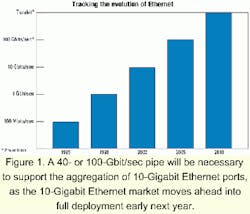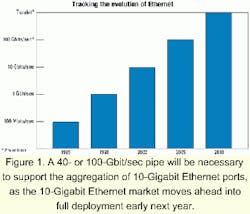Scaling to 10-Gigabit Ethernet and beyond
Coarse WDM devices offer the ability to scale the LAN for less cost than WDM solutions.
KIRK BOVILL, Blaze Network Products
It used to be that optical implementations were meant for long-haul wide-area- (WAN) and metropolitan-area-network (MAN) markets. Not any more. The Internet has pushed bandwidth requirements further down the networking chain. Indeed, the number of optical ports used within the LAN space has increased at a steady rate for the past six or seven years.
It is estimated that nearly five million Gigabit Ethernet (1-Gbit/sec) ports will ship into the LAN space this year. A 10-Gigabit Ethernet (10-Gbit/sec) solution is needed to aggregate this data as it moves closer to the core of the network. As the 10-Gigabit Ethernet market moves ahead into full deployment early next year, a 40- or 100-Gbit/sec pipe will be necessary to support the aggregation of 10-Gigabit Ethernet ports (see Figure 1).
How is this going to be achieved in the cost-sensitive LAN market? WDM integration with optoelectronics is a logical answer to the scaling issue, but this solution doesn't address the pricing expectations of the LAN market. The development of coarse wavelength-division multiplexing (CWDM), however, will enable the design and manufacture of devices that cost less than traditional WAN-centric WDM solutions.
CWDM-based devices are optimized for the LAN space and offer the ability to scale to data rates far beyond 10 Gbits/sec. In addition, these devices can be deployed within existing premises-cabling infrastructures, extending the life of the end user's installed cable plant.
As with any WDM-based device, CWDM multiplexes a number of optical wavelengths (or channels) down a single fiber to create an aggregate bandwidth that is the summation of the data rates of each individual wavelength. The difference between traditional DWDM and CWDM techniques is that the spacing between the optical wavelengths is much wider in a CWDM implementation. Typically, a CWDM-based optical device will use a spacing of 20 nm between wavelengths. DWDM-based optics are more tightly controlled, with optical spacing of <1 nm between wavelengths. DWDM can aggregate a larger number of optical channels into a single fiber, but the complexity and cost of this design is much higher than that of CWDM. DWDM was designed for use in the WAN space, where as many as 160 channels are pumped through a single fiber in long-haul telecommunications applications. In contrast, CWDM is optimized for four to 16 channels for deployment in the LAN space and some of the MAN market.
CWDM devices have integrated the optoelectronics with WDM functions into small packages that have been optimized for future networking gear designs that require high port densities. A CWDM optical subassembly that has integrated active optical components, filtering, lensing, and ferrule elements into a package that is 20x10 mm is shown in Figure 2.
Complementary metal-oxide semiconductor (CMOS) technology is used in these devices, which allows for lower power consumption, requiring only 1-2 W to be dissipated. Thermal performance of CWDM devices will be much better than some of the serial devices, which dissipate almost 10 W. Since the CWDM device is a four-channel transceiver, it is optimized for the IEEE's 10-gigabit extended attachment unit interface (XAUI), there isn't a need for any additional chipsets. The serial transceivers require a set of serializer/deserializer (SerDes) chips to convert the four-lane XAUI electrical path down to a single path, strip off the 8B/10B coding, recode with 64/66, then repeat the process in reverse order in the receive direction. As of this writing this particular chipset is not available, so the practical use of the serial devices will hinge on chip vendors being able to supply the solution.The CWDM design is optimized for small-form-factor 10-Gbit/sec packages. Initial devices will be about the same size as a standard Gigabit interface converter. These devices will utilize an SC connector interface, which will keep the costs down by not requiring the use of more expensive ribbon-fiber alternatives for the interconnection scheme.
Low-cost 850-nm short-wavelength laser sources are utilized within CWDM devices targeted for the short-reach applications of the 10-Gigabit Ethernet market. More expensive 1,300-nm laser sources are used in CWDM devices for longer-reach LAN applications. Serial solutions are being developed in the wavelength ranges of 850, 1,300, and 1,550 nm.
The current street price of a CWDM-based 850-nm device is about half the cost of an 850-nm serial solution and about one-third the cost of the 1,300-nm DWDM transceivers. The 1,550-nm solutions are approximately double the price of the 1,300-nm CWDM transceivers.
The 850-nm CWDM solutions have integrated the vertical-cavity surface-emitting lasers (VCSELs) widely used for Gigabit Ethernet and Fibre Channel devices. Thus, the cost of these optical sources is very low. According to ElectroniCast, an independent research firm, the market for VCSEL transceivers tripled in consumption in 1999 from the previous year.
The serial devices developed by many transceiver manufacturers require a set of SerDes chips for electrical-to-optical conversion, which adds cost and increases power consumption within the device. The initial costs of the chips are very high. Although costs are not expected to stay in the triple digits too long, the reality is that SerDes chips will never be free in any implementation; these chips will always add cost.
The 850-nm serial solution is challenged by distance and may not see the volumes necessary to drive down the cost of the 10-Gbit/sec VCSELs for some time. Without significant volume, the likelihood that it will catch up with the 850-nm CWDM device on price parity is doubtful. The 850-nm CWDM devices will hit the sweet spot for the price-sensitive LAN designers on short-reach applications, thus driving down their costs with the volume generated in this space. As 10-Gbit/sec 850-nm lasers become available and the costs start to come down, the CWDM camps will integrate the lasers into higher-bandwidth 40-Gbit/sec and 100-Gbit/sec devices.The 1,300-nm and 1,550-nm transceivers will always have higher costs due to the use of distributed-feedback (DFB) lasers rather than VCSELs for their light sources. However, work is underway to develop VCSEL alternatives in both wavelengths, which will lower the cost. The 1550-nm devices will not have the price pressures of the other transceivers, since these devices are geared toward the long-haul portion (>40 km) of the 10-Gigabit Ethernet standard, and there currently is no competing technology. The 1,550-nm transceivers are not expected to represent a large percentage of the market.
Volume-driven manufacturing techniques have been developed and optimized for CWDM transceiver packaging. Alignment challenges, small-volume fixturing, and a lack of automated processes have always been the bottlenecks in WDM-based systems. The CWDM transceiver developers have worked closely with manufacturing equipment companies to create tooling that has the capability of producing thousands of devices per month to support the 10-Gigabit Ethernet market requirements.
WDM technology by nature is scalable, and CWDM is no different. More channels can be added, lasers that operate at higher data rates can be integrated, or a combination of both approaches can be used to create faster, bigger optical pipes.
As the IEEE 802.3ae 10-Gigabit Ethernet standard moves to completion in the March-to-June time frame of 2002, work has already begun on 40-Gbit/sec projects within the LAN community. In addition, it can be assumed IEEE 100-Gbit study group efforts will get underway sometime in late 2002 or early 2003. That is the nature of an industry where everything used to be measured against Moore's Law, but now marches to a performance curve driven by the Internet. According to the U.S. Commerce Dept., the optical core bandwidth requirements of the Internet are doubling every four months. Finding a place to use the bandwidth is not the concern. Getting the bandwidth to support newer applications such as voice over IP and videoconferencing is the challenge.
It's too early to make a call in the 10-Gigabit Ethernet space as to which technology choice will become the clear winner. There will be enough demand in each application space defined within IEEE 802.3ae's market requirements to support more than one transceiver selection.
There is strong interest within the optics community to develop a pluggable version of 10-Gbit/sec devices. The intent is to have the most compact design that supports the largest number of transceivers, giving the system designer maximum configuration flexibility and minimizing the number of different board designs that a company would need to support in their manufacturing and marketing plans. Work has started within the group, which has already targeted products to line up with customer requirements and standards timelines.
The reality is that networking equipment companies are willing take anything they can get their hands on at the moment. The optics vendor that can produce more than vaporware will have a clear advantage in the market. Time-to-market and time-to-volume challenges are what every vendor is faced with as the industry moves toward steroid-enhanced optical pipes.
Remember when we used to get excited about Gigabit Ethernet? Get ready for 100-Gigabit Ethernet. It should be making its debut in 2005, give or take a year.
Kirk Bovill is director of product marketing at Blaze Network Products (Dublin, CA).


